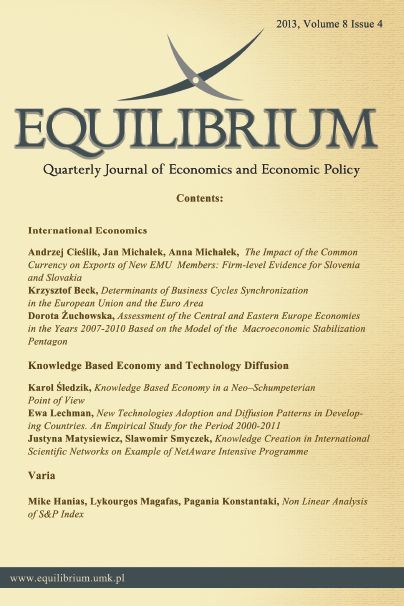Determinants of Business Cycles Synchronization in the European Union and the Euro Area
DOI:
https://doi.org/10.12775/EQUIL.2013.025Keywords:
business cycles synchronization, theory of optimum currency areas, convergence, economic specialization, economic integrationAbstract
Further economic and monetary integration in Europe is currently on hold due to the crisis and even questions about the possible exile of Greece. Especially in those conditions, it is important, to see whether integrated Europe can handle future problems and if economic and monetary integration can be helpful or rather more problematic. The main aim of this paper is to check to what degree business cycles are synchronized in the Eurozone and the European Union and what the main determinants of business cycles synchronization are. To achieve this, the following steps have been taken. Firstly, we turn to optimum currency area theory, to see what conditions need to be met, if the European Union and the euro area can use common monetary policy to deal with some economic shocks. Then, all necessary methodological explanations are presented. Later on, the preliminary data analysis is employed to see how business cycles and their determinants were acting during the last 20 years. Finally, panel data analysis is used to check how those determinants actually influence business cycles synchronization. The main finding of the article is that even though business cycles synchronization has been progressing in the European Union and the euro area so does the specialization ? divergence in production structure. This may result in less synchronized business cycles in the future.
Downloads
References
Bayoumi T., Eincheergreen B. (1992), Shocking Aspects of European Monetary Integration, NBER Working Paper No. 3949. January.
Beck K. (2011), Akcesja Polski do strefy euro w świetle teorii optymalnych obszarów walutowych - weryfikacja empiryczna [in:] S. Lis (ed.), Kontrowersje wokół akcesji Polski do Unii Gospodarczej i Walutowej, Wydawnictwo Uniwersytetu Ekonomicznego w Krakowie, Kraków.
Beck K., Możdżeń M. (2011), Instytucjonalne przyczyny kryzysu w Stanach Zjednoczonych [in:] A. Prusek (ed.), Wyzwania polityki ekonomicznej w warunkach światowego kryzysu finansowego i gospodarczego, Wydawnictwo Uniwersytetu Ekonomicznego w Krakowie, Kraków.
Bukowski S. (2007), Unia monetarna teoria i polityka, Difin, Warszawa.
de Grauwe P. (2003), Unia Walutowa, Polskie Wydawnictwo Ekonomiczne, Warszawa.
de Grauwe P. (2007), Economics of Monetary Union, Oxford University Press, New York.
Fatás A. (1997), Does EMU Need a Fiscal Federation?, INSEAD and CEPR, Economic Policy Panel, October.
Frankel J., Rose A. (1997), The Endogeneity of the Optimum Currency Area Criteria, CPER.
Friedman M. (1953), The Case for Flexible Exchange Rates, "Essays in Positive Economics", The University of Chicago Press, Chicago.
Friedman M. (1968), The Role of Monetary Policy, "The American Economic Review", Vol. 58, No. 1.
Hallwood C.P., MacDonald R. (2000), International Money and Finance, Blackwell Publishing, Oxford.
Horvath R., Komarek L. (2002), Optimum currency area theory: an approach for thinking about monetary integration, Warwick Economic Research Papers No 647. Warwick.
Jurek M. (2004), Development of the Optimum Currency Areas theory - some issues, "Poznań University of Economics Review", No 4.
Kenen P. (1969), The Theory of Optimum Currency Areas: An Eclectic View [in:] R. Mundell, A. Swobod (ed.), Monetary Problems in the International Economy, University of Chicago Press, Chicago and London.
Kenen P. (1966), Toward a Supranational Monetary System, "International Economics Workshop", Columbia University.
Krugman P. (1993), Lessons of Massachusetts for EMU, "Adjustment and growth in the European Monetary Union", CEPR, Cambridge University Press, New York.
Lee G., Azali M. (2009), The Endogeneity of The Optimum Currency Area Criteria in East Asia, Discussion paper 15/09. Monasch.
Lucas R. (1972), Expectations and the Neutrality of Money, "Journal of Economic Theory" Vol. 4.
Lucas R. (1976), Econometric Policy Evaluation: A Critique [in:] K. Brunner, A. Meltzer (ed.), The Phillips Curve and Labor Markets, North Holland, Amsterdam.
Maes I. (1992), Optimum Currency Area Theory and European Monetary Integration, "Tijdschrift voor Economie en Management", Vol. XXXVII, No. 2.
McKinnon R. (1963), Optimum Currency Areas, "American Economic Review", No. 53.
McKinnon R. (2001), Optimum Currency Areas and European Experience, "Stanford University Press", Stanford.
Meade J. (1957), The Balance-of-Payments Problems of a European Free-Trade Area, "The Economic Journal", Vol. 67, No. 267.
Mongelli F.P. (2002), "New" Views on the Optimum Currency Area Theory: What is EMU Telling Us?, European Central Bank Working Papers No. 138. April.
Mundell R. (1961), A Theory of Optimum Currency Areas, "American Economic Review", No. 51.
Mundell R. (1997), Updating the Agenda for Monetary Union, Extended version of a luncheon speech presented at the Conference on Optimum Currency Areas, Tel-Aviv University, December 5.
One market, one money. An evaluation of the potential benefits and costs of forming an economic and monetary union (1990), European Economy No. 44.
Phelps E. (1967), Phillips Curves, Expectations of Inflation and Optimal Unemployment over Time, "Economica", New Series, Vol. 34, No. 135.
Raport na temat pełnego uczestnictwa w trzecim etapie Unii Gospodarczej i Walutowej, NBP,
Silvestre J., Mendonça A., Passos J. (2007), The Shrinking Endogeneity of Optimum Currency Areas Criteria: Evidence from the European Monetary Union -A Beta Regression Approach, ISEG Working Paper 022. DE 2007.
Tavlas G.S. (1993), The 'New' Theory of optimum Currency Areas, "The World Economy", Vol. 16, No. 6.
Tavlas G.S. (2004), Benefits and Costs of Entering the Euro zone, "Cato Journal", Vol. 24, No 1-2.
Warin T., Wunnava P.V., Janicki H.P. (2008), Testing Mundell's Intuition of Endogenous OCA Theory, IZA Discussion Paper No. 3739.September.






